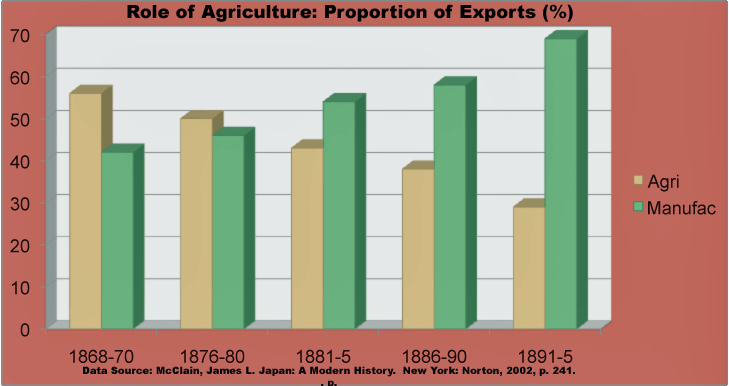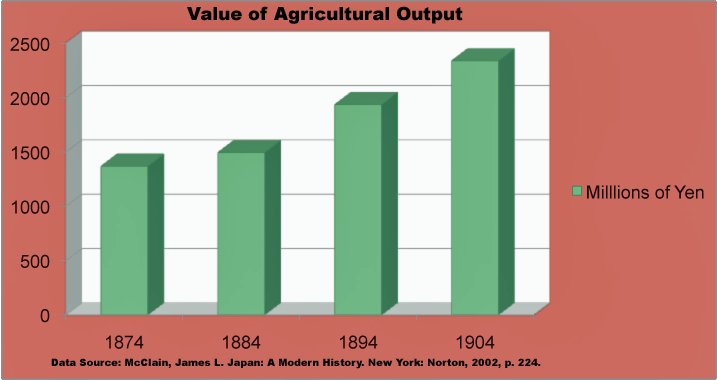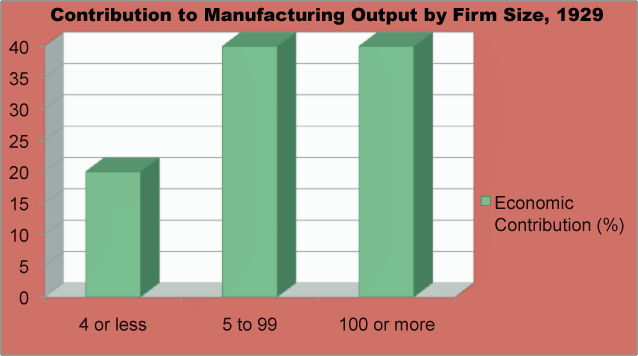
Gross domestic product, 1885-1920
Overall 280% growth
Agri, forestry, and fisheries—67%
Commerce and services—180%
Mining and manufacturing—580%
Trans., communic., pub. utilities—1,700%
Government
30 to 40% of all investment, 1897-1914
Heavy industry
Infrastructure
Private initiative
Light industry
*Crony capitalism?
Based on the two charts below, what was the role of agriculture in Japan's industrial revolution?


Raw silk
Tea
Silk textiles
1868-1912
2% annual growth in agricultural output
1% annual pop growth
More than half of government tax revenue until 1890s

2 Agricultural colleges, 1870s
Ministry of Agriculture and Commerce, 1881
Agricultural societies, 1880s
Rice farming
Transplanting seedlings
*Silkworm hatching
Labor intensive
Feeding 8x/day
Cleaning 3x/day
Natural breed
April-June
New breed, 1870s
July-September
Silk production, 1880-1930
1000% increase
Farm work days, 1880-1930
40% increase
Silk and silk products
40% of exports, 1900
30% of exports, 1930
Military related industries
Iron, ships, munitions
Need for "productive power"
Public investment
#11 Okuma Shigenobu, Finance Minister
Currency unified (Yen), 1871
National Bank, 1872
Tax reform, 1873
Tokugawa land tax
Fixed payments based on village productivity ca. 1600
Payment in rice
Meiji Reform
3% land tax based on assessed value
Payment in cash
Telegraph
Government Railroads
Tokyo-Yokohama RR, 1872
Osaka-Kobe RR, 1874
Extended to Kyoto, 1877
Less than 200 miles, 1881
Cotton and silk spinning factories
Loans to 3 private investors
Government purchased factories
Tomioka Silk Reeling Factory, 1872
Mizunuma Silk Mill, 1872
Unprofitable
Inflationary policies
Deficit spending
Liberal constitutional ideals
Deflationary policies, 1881
Divestiture, 1884
How did the cotton thread industry fare after government divestiture of factories?

Privatization encouraged, 1881
Nippon Railway founded
Nationalization, 1907

Family owned
Close ties to government
Mitsui
Mitsubishi
Sumitomo
Yasuda
Iwasaki Yataro, 1835-85
Farming family
Tosa financial manager, 1865
*Crony capitalism?
Tosa assets and debts, 1870
11 steamships and other enterprises
Meiji steamships, 1874-5
Nagasaki Shipyard, 1883
Dry goods stores, 1800s
Supplied Tokugawa armies
*Crony capitalism?
Collected public tax revenues, 1868-82
Miike coal mine, 1888
Mitsui Bank
Loans to govt officials, 1870s-80s
Tomioka Silk Reeling Factory, 1893
Based on the chart below, what was the relative importance of small businesses and Zaibatsu in Japan's economic development?
